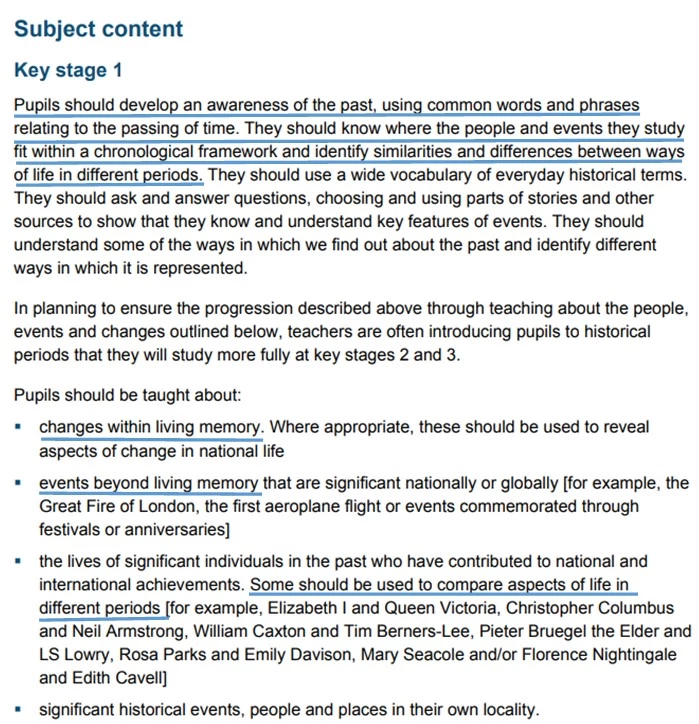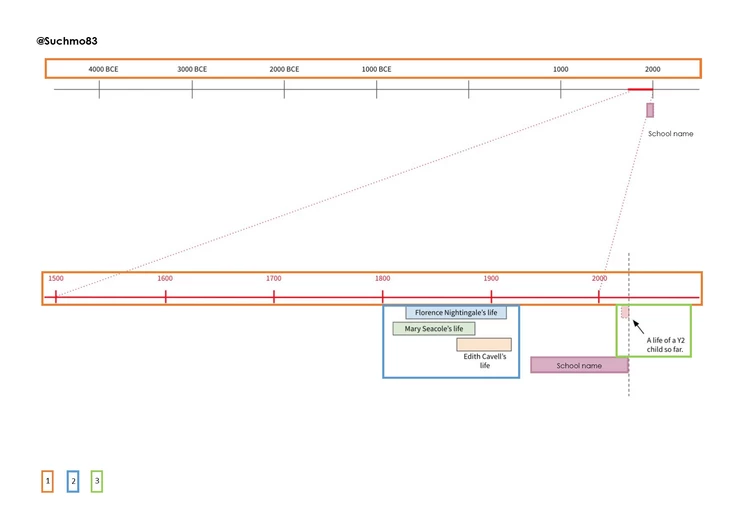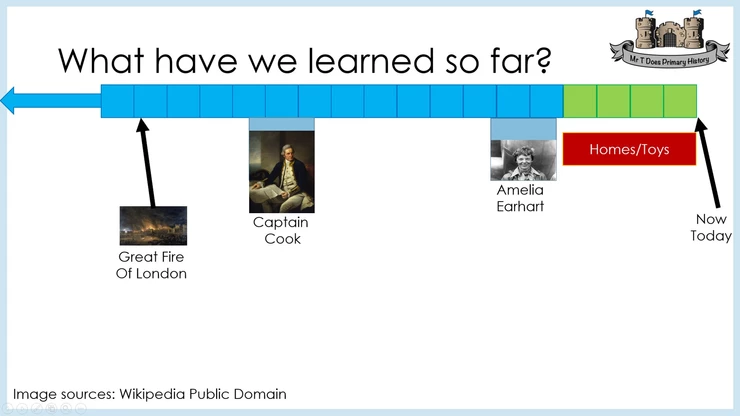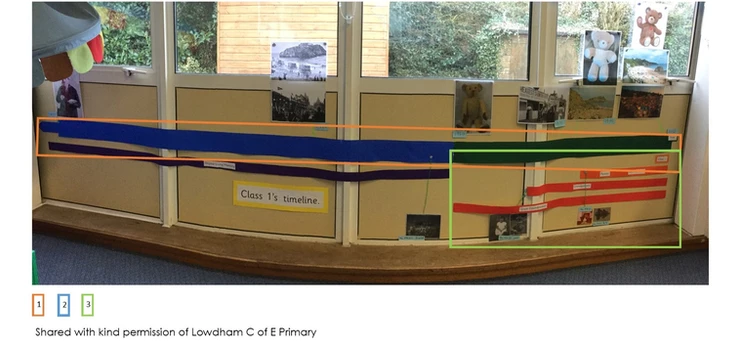Key Stage 1 Chronology Display Blog
This blog should ideally be read in conjunction with the Key Stage 2 post which can be found here. The purpose of this post is to ensure that children reach the end of Key Stage 1 ready to build on their chronological understanding in Year 3.
EYFS
The new EYFS framework which comes into effect in September has a strong emphasis on the subject discipline of history. The ELG: Past and Present (P14) emphasises the beginnings of chronological understanding by ‘Know[ing] some similarities and differences between things in the past and now,’ and ‘Understand the past through settings, characters and events encountered in books read in class and storytelling.’. On a personal level, this would bring in line the curriculum approach with that of KS1 and 2.
If we spend time reading the Key Stage 1 element of the National Curriculum 2014 (NC), the many references to chronology should become clear. It can be broken down into two sections:
· An awareness of the past, using everyday vocabulary
· Chronological position (framework)
These are both fundamental and should be evident every time history is taught. The main focus of this particular blog is that ‘They should know where the people and events they study fit within a chronological framework and identify similarities and differences between ways of life in different periods.’ from the KS1 subject content paragraph. But please remember that this should be done in conjunction with the development of vocabulary to show the passing of time.
Key Stage 1 Objectives:
Here is an annotated screenshot of the subject content for KS1. All of the content which is explicit chronology or chronologically underpinned is underlined. What stands out?

Hopefully what’s clear is the way in which chronology underpins every aspect of the knowledge that we teach. In terms of using a central chronology display, there are a number of key ways this would support the development and then application of a greater chronological understanding.
What to Include:
Let’s begin with the obvious. Every suggestion is space dependent! With that in mind, there are two branches of chronology to consider:
1) the overall narrative (framework as the curriculum names it).
2) the internal narrative being studied in depth during a particular topic.
After positing on social media about this blog, I had a couple of people send through their examples. The first, from @Suchmo83 on twitter shows both examples using an expanded narrative below the overall picture.

As you can see, the link is established as to how the scale changes and there is a distinction between single events and duration. This is exactly the way in which I represent it – we both agree consistency of approach is key! He is writing a blog on this which I will link when it goes live. The coloured, numbered key relates to explanation below.
The question around using a numbered scale is an interesting one. If we use the curriculum specification, then ‘common words and phrases’ and ‘chronological framework’ are specified which would imply that no numbered scale is needed. In addition, children’s knowledge and understanding of place value in maths is 100 so are we going to add confusion by insisting on a numbered scale they won’t comprehend? Whilst talking to Chris, he said that no child is expected to use the numbers in Key Stage 1 but the consistent timeline across school means they are exposed to it in Y1 and 2 before making more deliberate and precise use in KS2. My own approach to this is below:

As a personal opinion, there are pros and cons to both but simple, effective and consistent are important which is why I use a colour-coded incremental scale for the overall narrative. I also have certain features which I use in all my timelines. First, scales are explicitly explained to ensure children understand what they are representing. Second, an arrow represents a single ‘point’ in time and a bar represents a longer duration. This helps highlight change over time and turning points more effectively. Chris’ scale would achieve a similar outcome because it’s consistent and developed throughout school in incremental steps. There is a fine balance between visual simplicity and accurately representing the complex narrative of history.
Interacting and Understanding

This second example uses a timeline to reinforce the key concept of duration. Within and beyond living memory are paramount to build on the EYFS’ ELG of now and past. It’s also really useful to have it at child height so that they can interact with it independently and under explicit instruction. The pictures directly relate to what has been studied/is currently being studied.
The colour-coded school to help reinforce the narrative of past starting at today, which is labelled as now, to anchor the understanding and then looking backwards to within living memory (what can be remembered by those alive today) and beyond it.
However your timeline looks, it’s crucial that understanding is built and children have the opportunity to engage with what it means and then what it represents:
1)The scale! This helps introduce children to key concepts such as interval and duration. In addition, it highlights the link between the timeline and mathematical understanding of graphs and bar modelling. Both examples have a clear scale which allows accurate placement of the lives of significant individual or to highlight where in history the changes within living memory ‘sit’.
2)The curriculum specifies ‘They should know where the people and events they study fit within a chronological framework and identify similarities and differences between ways of life in different periods’ and by having a clear timeline setting the overall narrative, this becomes an easier task. It supports children to use everyday vocabulary such as before, after, earliest etc. This isn’t depicted on the second image as the example comes from their first history topic of the year. It will, however, be built up and added to as their knowledge base increases.
3) In EYFS and KS1, using the child’s own lives so far is a good start point to support them understanding that the past is what has already happened and they can remember a small fraction of it. That’s where the original idea for depicting living memory in image two came from including the overlap of grandparents’ living memory including the parent’s and child’s. Image 1 does the same using the child and also the history of the school which ties into their taught curriculum.
Where and when to teach it?
Setting the context is really important. Chronological understanding is built up and reinforced as part of each topic and then a way to link between them. Always begin teaching with context to introduce where and when in the past this new topic sits (that’s the overall narrative). In addition, it’s also a good place to introduce the core vocabulary using a knowledge organiser as both help to master the minimum knowledge (phrase shamelessly stolen from @MrBartlettHist’s recent teachmeet session). In addition, keep reinforcing this understanding of the internal narrative throughout. It helps to highlight the significance of a point in someone’s live, a turning point for an event or the legacy of said point.
Where next?
By the end of KS1, what do we want the children to understand about chronology? This is an initial unedited list of initial thoughts as I intend to refine and revisit when I’ve considered it in more depth:
1) Chronology is a way to understand how history ‘fits together’. We can use timelines to understand where our learning sits in the past and begin to compare it.
2) We start reading timelines from now and always work backwards into the past. Time flows from left to right.
3) The scale of history. Within living memory is a much shorter duration than beyond.
4) There is so much more history to be studied than we have learned so far.
5) Use relevant vocabulary and begin to talk about the narrative they have learned. The earliest event was the GFoL, after that was Florence Nightingale and Edith Cavell etc.
What next?
In Key Stage 2, periodisation of the past to show the greater breadth of study we teach and the more precise way our scales and timelines are depicted. These are good next steps for year 3 to begin with.
Bibliography:
https://www.aft.org/periodical/american-educator/summer-2004/ask-cognitive-scientist
https://www.teachprimary.com/learning_resources/view/how-to-teach-chronology-in-ks1-ks2
https://www.history.org.uk/primary/resource/4100/how-to-teach-chronology
https://discovery.ucl.ac.uk/id/eprint/10118307/1/What-Should-Schools-Teach.pdf
http://eprints.glos.ac.uk/7775/1/7775%20Butler%20%282017%29%20Chronological%20Understanding.pdf
https://teacherhead.com/2014/02/16/teaching-the-timeline-chronology-as-core-curriculum/
Books:
Understanding and Teaching Primary History by James Percival pp34 – 53 in particular
Mastering Primary History by Karin Doull, Christopher Russell and Alison Hales
